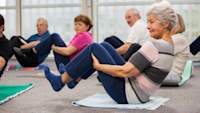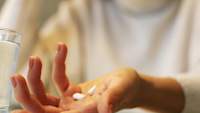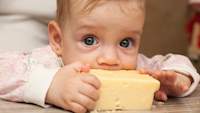无论你刚刚被诊断或担心,你可以开发骨质疏松症,你可能紧张,困惑,甚至有点害怕。这是正常的,每个人都特色在HealthCentral有一种慢性疾病,感觉就像你现在要做的。但是,我们和他们,在这里为您服务。On this page alone, you’ll not only discover the realities and challenges of the condition, but also the best treatments, helpful lifestyle changes, where to find your osteoporosis community, and all the critical information to help you not just manage—but thrive. We’re sure you’ve got a lot of questions...and we’re here to answer them.
Our Pro PanelOsteoporosis
我们邀请了几位最好的专家在该领域的最科学,最先进的最新信息成为可能。

Stephen Honig, M.D.Rheumatologist and Director

Kendall Moseley, M.D.Medical Director

Mary Jane Minkin, M.D.Clinical Professor of Obstetrics, Gynecology, and Reproductive Services
What Is Osteoporosis, Anyway?
Getting a big break is generally a good thing, unless, of course, we’re talking about bones and you’re an aging adult. Then it tends to conjure thoughts of骨质疏松。该词语翻译porous, or soft, bone。Osteoporosis is a bone disease that occurs as yourbones weaken, thin, and become so fragile, they’re vulnerable tofracture(这是医学术语为骨折)。大约有1000万美国人患有骨质疏松症,和惊人的4400万低骨量,这使得它们在发展的脆骨状态的风险,根据国家骨质疏松基金会(NOF)。
To better understand osteoporosis, we need to talk about bone development. Here’s a crash course:
- Your bones are a work in progress for most of your life, but the bulk of your bone-building happens when you’re a child and a young adult.
- Bones are made ofcollagen, a protein that gives them some amount of flexibility, and alsocalcium phosphate, a mineral that gives them their strength and hardness.
- The cells that build new bones are called成骨细胞andosteocytes。Osteoclasts are cells that break down old bone and release calcium into your blood.
- Around age 30, we hit what’s calledpeak bone mass—the strongest our bones are going to get. From ages 30 to around 50, your bone mass is pretty stable; you’ll lose some bone (a.k.a.resorption) and make some new bone (known asostosis),让你的整体骨密度保持大致相同的(称为工艺bone remodeling).
- After 50, especially if you’re a woman going through menopause (more on this later), you start to lose bone more rapidly. If the bone loss outpaces the formation of new bone, you may end up withlow bone densityor even osteoporosis.
Under a microscope, the inside of healthy bone has a honeycomb-like appearance, meaning there are some small holes. But the microscopic view of an osteoporotic bone looks more like Swiss cheese; those holes are much bigger. Without medical intervention (namely osteoporosis medications), the bone loss and fragility will only get worse. Someone with severe osteoporosis can fracture a bone simply by coughing too hard or twisting the wrong way. Ouch!
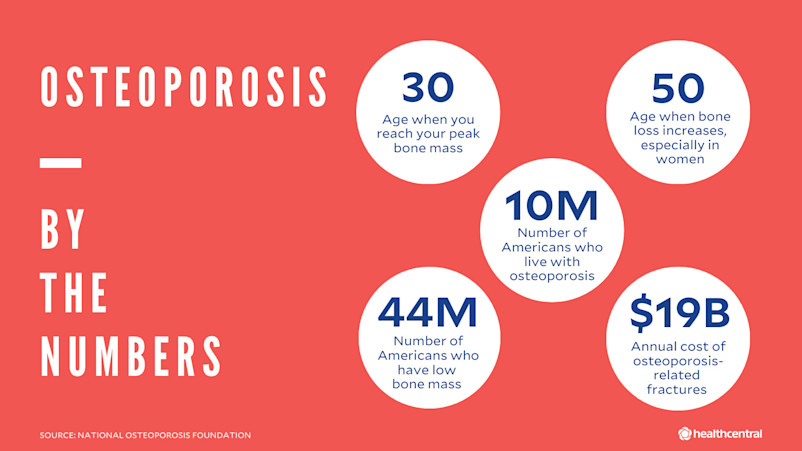
What Causes Osteoporosis in the First Place?
All osteoporosis stems from low bone density, but how exactly do bones go from honeycomb-solid to weakened and resembling a wedge of Emmental? Many contributors to low bone density are beyond our control, but others are very much within it. Here’s what you can’t do much about:
- 遗传学:About 80 percent of our peak bone mass is inherited. That means the bulk of your bone make-up is determined by mom, dad, or your dear grandmother, who had osteoporosis.
- Assigned gender:Women have smaller, thinner bones than men, so they tend to have a lower peak bone mass to start with. Men can get osteoporosis, too, but it’s far more common in women, especially post-menopausal white and Asian women. One in two women (versus one in four men) ages 50 and older will have an osteopathic bone break. The relationship between estrogen and osteoporosis is an important one, too. Estrogen is thought to boost those bone-building osteoblast cells. So, when estrogen plummets after menopause, bone mass tends to as well.
- Age:Maintaining that peak bone mass you had at 30 is like trying to stay your wedding-day weight--never going to happen. We slowly start to lose bone mass at age 40 and more rapidly in the next decade.
- Body frame:Having a petite frame can up your risk of developing the bone condition. A slight frame is associated with slight bones.
- Ethnic background:那些与北欧和亚洲的根源更易患骨质疏松症。与地中海和非洲裔背景的人往往有较高的峰值骨量,提供了对骨质疏松症提供额外的保护。
- 所患疾病和药物:Certain conditions such as hyperparathyroidism, celiac disease, and rheumatoid arthritis can spur bone loss, leading tosecondary osteoporosis(when a condition or treatment interferes with attaining peak bone mass and causes bone loss). Medications, including the long-term use of oral steroids and cancer drugs, can also affect bone health.
Now for those osteoporosis risk factors that youcancontrol? These include:
- Weight:Being very thin is associated with a higher risk of osteoporosis, as a slender figure is associated with thinner bones. For women, weighing less than 127lbs or having a BMI less than 21 seems to increase your risk. Being overweight doesn’t help either. Obesity can lead to conditions such as diabetes, which can accelerate bone loss.
- 饮食:Calcium is the building block of strong bones, and vitamin D helps your body absorb the mineral. A diet that’s low in either one can result in a lower-than-normal peak bone mass. Eating a low-carb diet or one that’s high in salt can also negatively affect bone density because both ways of eating can increase the amount of calcium excreted through urine. Having an eating disorder, such as anorexia, can also rob your bones of essential nutrients. (Plus, as we’ve noted, being underweight can put you at risk.) Similarly, those who have limited their diet following weight loss surgery lack in essential nutrients and vitamins, and their bones can suffer as a result.
- Smoking:Add it to the list of reasons tofinallyquit: Tobacco use has been linked to low bone density. It’s thought to affect blood circulation throughout your body, including your bones (you have blood vessels and veins within the marrow of your bones), weakening them over time.
- Heavy drinking:The relationship between bone density and alcohol is hazy. Some studies have shown light-to-moderate drinking (one to two drinks a day) can boost bone density, but drinking more than two drinks a day, especially hard liquor, can reduce it by interfering with your calcium and vitamin D levels, and lowering hormone levels. And, of course, if you’re tipsy, you’re more likely to fall, which can increase your chance of fracturing.
- An exercise routine (or lack thereof):Weight-bearing exercises (those that require you to work against gravity to support your body weight) help build healthy bones. Think: walking, hiking, dancing, climbing stairs and jogging, to name a few. So if you don’t move much or favor non-weight bearing activities such as swimming, you could end up with low bone density. On the flip side, extreme athletes who, say, run marathons, may have low body fat and estrogen levels, increasing their chances of developing porous bones, too.
- Emotional stress:New research suggests that stress may play a role in bone health. (Is thereanythingstress doesn’t affect?) Women with high levels of stress had lower bone density six years later compared to those with lower stress levels, a study in the流行病学杂志和社区的Health showed. Exactly how psychological stress affects bones isn’t well understood, but researchers believe stress contributes to system-wide inflammation, and inflammation can slow down成骨细胞(bone-forming cells) and promoteosteoclasts(细胞击穿骨)。其他研究已发现,抑郁症,降低骨质密度。
Think you may be at risk for osteoporosis? Knowing you’re prone to osteoporosis is one of the best ways to catch this condition before it's too late.
Read MoreWill I Experience Symptoms of Osteoporosis?
Probably not. Osteoporosis is often a silent disease. In fact, most people don’t know they have it until—bam!—they break a bone. Fractures in specific areas—your spine, hip, or wrist—that occur without a large amount of trauma is a red flag for your doctor. One of the most common breaks that people with osteoporosis tend to get is aspinal compression fracture(a.k.a. collapsed vertebrae). If you have osteoporosis, you can get one of these fractures without even falling; sometimes by simply twisting the wrong way. In that case, you may notice pain in your back.
Also, there’s a reason you may picture a hunched-over old lady at the mere mention of osteoporosis. Shrinking significantly in height or developing poor posture are both signs of the condition. It’s normal to lose half an inch per decade after age 40, but more than that could be due to osteoporosis.
How Do Doctors Diagnose Osteoporosis?
So if osteoporosis is usually silent, how does it manage to get noticed? It’s typically found two ways: most often, after a脆性骨折(休息,从创伤低量的结果),或一个例程期间bone density scan。
Fragility Fractures
If you’ve just fractured a bone that’s vulnerable to osteoporosis (hip, spine, wrist), and have some of the risk factors (say, you’re a post-menopausal woman or have a family history of porous bones), your doctor doesn’t even have to check your bone density to know that you have the condition. The fracture alone is enough to confer the diagnosis.
Bone Density Scan
不过,你的医生可能会送你一个骨密度扫描,测试测量你的bone mineral density (BMD)。The most common BMD test is adual-energy X-ray absorptiometryorbone densitometry,称为测定仪或用扫描仪。它使用一个低level of radiation to measure even small amounts of bone loss. It’s typically done on the lower spine and hips on an outpatient basis at a radiology facility or medical office, and takes less than 30 minutes. Wear comfy clothes without zippers, and let your technician know if there’s any chance you could be pregnant. You’ll also need to avoid calcium supplements for 24 hours prior to the test.
Your BMD results come in the form of a numerical score called aT-score, a measure of how your bones stack up to a 30-year-old adult of the same gender. Now, if you’re 75 years old, that hardly seems fair, right? So, why age 30? That’s when we typically hit peak bone mass, so the test shows just how far (or little) your bone mass has strayed since then. How to read your T-score?
- -1和较高被认为是正常的,......你有健康的骨骼
- -1.1 to -2.4 is consideredosteopenia, low bone density that’s not osteoporosis
- -2.5 and below qualifies as osteoporosis—soft, fragile bones that are at risk of fracture
The T-score helps your doctor decide the best osteoporosis treatment for you.
如果你还没有断裂任何东西,你可能会得到你的诊断,虽然常规骨密度扫描。当你能想到吗?美国预防服务工作组(USPSTF)建议绝经后的妇女接受他们的第一次扫描65岁;在风险的妇女可以开始在60然而,许多妇科医生宁愿几年更年期内做一个基线扫描。该USPSTF没有一个男人的建议,但其他组织,包括美国国家骨质疏松症基金会,建议70岁男人的筛选。
The FRAX Test
Your physician may also recommend aFRAX test, which uses your bone density and other risk factors to determine how likely you are to fracture a major bone (hip, spine, forearm, or shoulder) within the next 10 years. Your FRAX score can also help determine your course of treatment.
你应该看到这类型的医生,如果你关注骨质疏松症?没有一个专家是完全奉献给条件。低骨密度和骨质疏松症可诊断和治疗由:
- Endocrinologists
- Gynecologists
- Rheumatologists
- Physiatrists (physicians who focus on physical medicine and rehabilitation)
- .中国ists
- Geriatric medicine doctors
Osteopenia vs Osteoporosis: What’s The Difference?
Osteoporosis is one of several skeletal systems diseases that can cause bone loss. There’s alsoosteopenia, which, as we mentioned above, is low bone density that has not quite reached the level of osteoporosis yet。
If you have osteopenia, you’re still at risk of fracture compared to someone with normal bone density, only less so than someone with osteoporosis. Experts say a diagnosis of osteopenia is often a wake-up call to their patients to take better care of their bones through diet and exercise, and to stop bone-destructive behaviors such as smoking. Osteopenia is typically not treated through medication.
Your doctor may also use a bone density scan to diagnoseosteomalacia(一个软化的骨头一般由维塔min D deficiency and digestive and kidney disorders) and骨的佩吉特氏病(骨重塑紊乱,可以是瘫痪)。
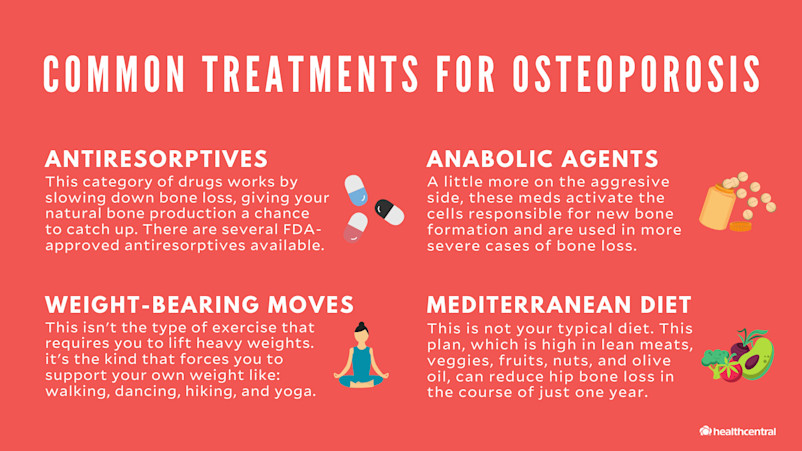
What Is The Best Treatment For Osteoporosis?
There areseveral widely prescribed osteoporosis medications, and while they may work differently, the overall goal is the same: prevent fractures. Not everyone with an osteoporosis diagnosis goes home with a script, at least not at first. If a woman in her 50s is diagnosed through a routine bone density scan, she’s active, healthy, and her FRAX score indicates that she’s at a low risk of fracture, she may not receive any treatment at all. For those with a higher risk of fractures, meds will probably be part of the picture.
Medications for Osteoporosis: You’ve Got Options
要管理你的骨质疏松症,防止其恶化,您的治疗计划可以包括以下类型的药物之一。
Antiresorptives
This category of osteoporosis drugs works by slowing down bone loss, giving your natural bone production a chance to catch up. Several types of FDA-approved antiresorptives agents are on the market today, including:
双膦酸盐:Oral bisphosphonates include Boniva (ibandronate), Fosamax and Binosto (alendronate), Actonel and Atelvia (riesdronate). They’re given daily, weekly, or monthly depending on the type. Reclast (zolderonic acid) is a bisphosphonate given via intravenous infusion once a year.
Possible side effects:
- Nausea
- 胃灼热
- Esophageal irritation
- Gastric ulcers
- Bone, joint, or muscle pain
The IV fusions can cause flu-like symptoms that stop within a few days after your treatment. You may have heard about a scary side effect calledosteonecrosis of the jaw但专家(血液供应颚骨的损失)说,这是极为罕见的,通常发生在人们对高剂量的癌症或有口腔手术后。
Another less common side effect is a fracture (ironic, right?), but not the type associated with osteoporosis. These meds can cause fractures in the upper thigh calledatypical femoral fractures。
RANKL inhibitor:Prolia (denosumab) is an injection given every six months.
Estrogen:Hormone replacement therapy (HRT) taken orally or via transdermal patch can help slow bone loss after menopause. Estrogen as an osteoporosis treatment is controversial because it’s been linked to health concerns, including breast cancer. Gynecologists will only consider it for patients dealing with severe menopausal symptoms (hot flashes, vaginal dryness, etc.)andlow bone density.
Selective Estrogen Receptor Modulators (SERMs):Evita (raloxifene), for instance, is an oral hormone-like medication that’s taken daily. Side effects of SERMs can include hot flashes, increased risk of blot clots, and temporary flu-like symptoms.
Tissue Specific Estrogen Complex (TSEC):Duavee (bazedoxifene) combines estrogen with an estrogen antagonist to treat menopause symptoms. It’s shown to increase bone mineral density in the hip and lumbar spine.
Anabolic Agents
These drugs help build up your bones, so they’re less likely to break. Their function is to activate成骨细胞, those cells responsible for new bone formation. They’re considered more aggressive in preventing fractures than antiresorptives, so are typically reserved for more severe cases—those at the highest risk of fracture.
Anabolic agents are limited to one or two years use (depending on the drug) due to potentially serious side effects. The drug romosozumab-aqqg increases your risk of heart attack and stroke, while teriparatide and abaloparatide have been shown in animal studies to cause osteosarcoma, a rare bone tumor, with long-term use.
后来,一个anti-resorptive规定马intain new bone growth. In some cases, an anabolic is prescribed in addition to a bisphosphonate: Combining the bisphosphonate zoledronic acid with the anabolic teriparatide boosted the bone mineral density in the spine and hip more than either drug alone, according to a study in theJournal of Bone and Mineral Research。
Anabolic agents are all administered through injections, including:
Evenity(romosozumab-aqqg), given once a month for up to a year
Forteo(teriparatide) andTymlos(abaloparatide), taken daily for up to two years
Possible side effects:
- Headaches
- Nausea
- 疲劳
- Joint pain
If a fear of side effects is keeping you off meds, know this: The benefits of fracture prevention (and associated complications) far outweigh the risks of taking osteoporosis medications, according to new treatment guidelines for postmenopausal women from the Endocrine Society published in* The Journal of Endocrinology & Metabolism*.
The guidelines state that women with a high risk of fractures should be treated, but then reassessed with a bone density scan after three to five years. If they’re no longer at risk, they can take a break from treatment. Women who are still at high risk should remain on the drugs. Your physician will track changes in your bone density (not less than every two years).
Other Types of Osteoporosis Treatments That Can Help
Osteoporosis is a chronic condition, absolutely, but there are a host of things you can do—in addition to typical meds—to help you feel your best. You may want to try the tactics that follow, with the help of specialists like a trainer or nutritionist.
秋季预防:A physical therapist or personal trainer can help you boost core strength, which is huge for improving balance. To reduce your chances of falling and suffering a break, you’ll want to:
- 穿低跟鞋与橡胶鞋底,
- Remove area rugs that may slip under your feet
- Always hold a rail when going downstairs
Weight-bearing exercises:This doesn’t necessarily mean heavy weight-lifting; it’s any exercise that requires you to support your weight: walking, dancing, hiking, yoga, yardwork. Resistance training with weights or bands can also build bone mass (muscles, too). If you’re at high risk of fracture, you’ll want to avoid jarring, high-impact workouts such as running, but these low-impact exercises are very much recommended.
饮食:Getting morecalcium—1200 mg a day for women and 1,000 mg for men--is key for bone building. Milk, yogurt, cheese, broccoli and sardines are all great sources. If you’re not big on dairy, a calcium supplement can fill in the gap.Vitamin Dhelps your body absorb calcium, and you can get it through sunlight and foods such as vitamin-D fortified milk and fatty fish. If your vitamin D levels are low (your doctor can check with a blood test), take a supplement. Beyond those vitamins, eating aMediterranean-based diet(lean meats, veggies, fruit, nuts, and olive oil) may reduce hip bone loss in one year, according to research from the University of East Angila.
To ease the pain associated with osteoporotic fractures, your doctor may recommend OTC medications including acetaminophen or ibuprofen. You might also want to explore these drug-free treatments:
- 针刺
- Biofeedback
- Massage
- 经皮神经电刺激,其通过电脉冲减少疼痛
Think you may have the symptoms of osteoporosis? Make sure you are familiar with your treatment options, too. Check out our guide to osteoporosis treatment here.
Read More骨质疏松症可逆吗?
To some extent, it can be. Your bones aren’t inert: There’s alwayssomeremodeling taking place within them. So, with the right treatment, exercise, and a good diet, you may actually improve your bone density. But doctors say stability—not losing any more bone mass, rather than building more of it— is what defines success with this condition.
Can You Prevent Osteoporosis in the First Place?
是的,骨质疏松症是可以预防的,在一定程度上。记住,你的峰值骨量的大部分是继承的,但你仍然有在许多骨建设的因素决定你的骨骼将如何结实,有弹性是控制(如低于)。
Think of your bones like a retirement account. If you start saving money early, planning for the days when you’ll no longer work, you’ll be ahead of the game when you need the money. Likewise, if you focus on building healthy bones before you start losing bone mass, you’ll have more “bone” in the bank when your body starts making withdrawals. But it’s never too late to start saving. If your BMD scan shows osteopenia, focus on these good bone habits:
Eat a bone-healthy diet, which means:
- Calcium-rich foods(dairy products, sardines and salmon with bones)
- Fruits and veggiesrich in calcium, magnesium, vitamin C and vitamin K (leafy greens, broccoli, red peppers, oranges) and fortified foods like cereals and bread
- Limiting foods and beverages that can interfere with calcium absorptionsuch as high sodium foods, excessive amounts of protein, caffeine and colas
- Taking a calcium and/or vitamin D supplementif needed
Do weight-bearing exercise for at least 30 minutes on most days
Quit smoking
Limit alcohol
Get enough sleep: Women who slept less than five hours a night had lower bone density than those who got the suggested seven hours of shut eye, a study in theJournal of Bone and Mineral Researchfound.
What’s Life Like for People Living with Osteoporosis?
If you’ve been diagnosed with osteoporosis in your 50s, and you make those important lifestyle changes to boost your bone health, chances are, your quality of life won’t be greatly affected. But people with more severe cases of osteoporosis who have had multiple fractures can suffer serious complications. Is osteoporosis painful? It can be. Plus, hip and spine fractures can lead to a loss of mobility, not to mention a loss of independence as well as financial stress due to healthcare bills.
You may also feel scared about falling or breaking bones, which can lead to anxiety and social isolation. Some people experience depression after repeated fractures, especially those that limit mobility. This can all cause a downward spiral, considering that anxiety and depression have also been shown to lower bone density. Having a support system, whether that’s a mental-health professional or an online community of people who share your struggles, may help alleviate some of your stress and concerns.
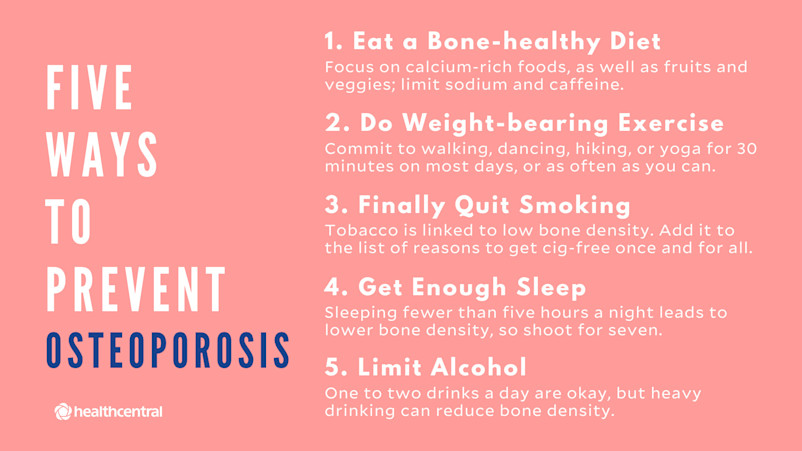
So, Where Can I Find My Osteoporosis Community?
骨质疏松症主要是一种无形的疾病。除非你有透视的眼光,你永远不知道还有谁在四处走动用多孔的骨头。在你的鞋子发现,有些可能需要多一点挖比它的其他条件。幸运的是,我们做了侦探为您服务。跳,并分享你的痛苦和成功案例,获得资源和教育,并希望从这些资源中汲取一些力量(名副其实)。
Top Osteoporosis Non-Profits and Support Groups
- 国家骨质疏松症基金会。This isthe领导机构骨质疏松和骨骼健康。当你在那里检查出通过的提示,统计,处理方案,以及最新的研究成果,下降到他们的在线社区Inspire.com与留言板主题,包括骨骼健康食谱,运动和物理治疗,对男性骨质疏松症或骨质减少,疼痛减轻的支持。
- American Bone Health。No bones about it, medical lingo can be confusing. This site translates the topic of bone density into easy-to-understand terms. There’s even a hotline you can call with specific questions. Take a quiz to see how vulnerable to fracture you are. Then pop into the online community to gain tips and support from people in the same boat.
- Save Our Bones。If you’re looking for holistic ways to strengthen your bones, the Save Institute’s Save Our Bones program can get you started. Here, you’ll get access to a free at-home kit, articles, and products that take a natural approach to bone density.
Top Bone Health-related Bloggers
Dr. Susan Brown, Ph.D., Better Bones,betterbones.com
They should call Dr. Brown “Dr. Bones,” because she focuses her life’s work on bettering your body by bettering your bones. As a medical anthropologist and a certified nutritionist, Dr. Brown prides herself on using only natural methods to help you build strong bones. Check out her science-backed six-point program that has helped tens of thousands of women rebuild their bone strength. Here, you can expect easy strength-training routines, nutrition tips, and the latest in bone research.
Dr. Lani Simpson, D.C., Bone Health Blog,lanisimpson.com
As a chiropractor and certified densitometrist (that’s “bone doctor” for those who don’t know), Dr. Simpson saw a need for integrated and holistic practices to come together to deliver patients the best of all medicine worlds. She brings research-backed info to her blog to help you choose the methods that are right for you.
Dr. Sophie Toland, Osteopathy, Anatomy and Yoga,sophietolandyoga.com
在她的青春期,许多受伤后Dr. Toland took to osteopathy—an alternative treatment that manipulates muscle tissue and bones—to rebuild her strength. She saw what it did to not only rebuild, but make her bones stronger, and she began helping others. Now, she combines her love of osteopathy, anatomy, and yoga—which, let’s face it, are all intertwined—into online courses to help others.
Top Osteoporosis-Related Podcasts
- Bone Talk。通过创建国家骨质疏松症基金会,这个播客/博客组合深入到有关管理你的痛苦,建立健康的骨骼,以及最新的研究对话。
- Bone Banter。As you’ve guessed, this science-y podcast covers international news and research related to bone health.
Frequently Asked QuestionsOsteoporosis
What causes osteoporosis?
The term osteoporosis means quite simply porous bones. Your bones get so brittle, they break. As adults, we’re always losing bone mass and building new bone. Osteoporosis develops when you lose more bone than you’re creating. The underlying cause is very low bone density, and that can stem from a whole host of factors including your genetics, assigned gender and hormones, your diet, and your lifestyle choices.
What is the relationship between diet and osteoporosis?
The cliché “you are what you eat” applies here. Bone is mostly made of calcium, so getting adequate levels is essential. People who didn’t get enough as children—or suffered from an eating disorder such as anorexia—don’t reach their full bone mass potential, which makes them more at risk for osteoporosis later in life. To build healthy, strong bones at any age, you want to get calcium and vitamin D through foods (dairy products, fatty fishes, calcium-rich fruit and veggies) and also eat food rich in magnesium, vitamin K, and vitamin K. Avoid high-protein and high-sodium diets, as well as heavy drinking, soft drinks such as Colas, and excess caffeine, all of which can interfere with your calcium levels.
How can I reverse osteoporosis?
You may not be able to cure your osteoporosis, but you can stabilize your bone density levels, and even improve them a bit, preventing future fractures. If you’re prescribed drugs by your physician, take them. Beyond meds, make sure you’re getting enough calcium and vitamin D, doing weight-bearing exercise, and limiting alcohol. And if you smoke, quit.
What is the best and safest treatment for osteoporosis?
When it comes to osteoporosis drugs, you’ve got a lot of options. The best one for you will be decided by your physician based on the condition of your bones. If you’re at high risk of fracture, you’ll likely be put on an oral drug (Fosamax or Boniva) that slows bone loss. If you’re at a very high risk of fracture, your doctor may jump to more aggressive injectable bone-building meds such as Forteo.
- 骨质疏松症的事实和数字:国家骨质疏松症基金会。(n.d.). “Osteoporosis Fast Facts.”cdn.nof.org/wp-content/uploads/2015/12/Osteoporosis-Fast-Facts.pdf
- Women, Weight, and Osteoporosis:Journal of Bone and Joint Surgery。(2003). “Older Women With Fractures: Patients Falling Through the Cracks of Guideline-Recommended Osteoporosis Screening and Treatment.”insights.ovid.com/bone-joint-surgery-american-volume/jbjs/2003/12/000/older-women-fractures-patients-falling-cracks/5/00004623
- Bone Density and Alcohol:American Journal of Clinical Nutrition。(2009). “The Effects of Beer, Wine, and Liquor on Bone Mineral Density in Older Men and Women.”ncbi.nlm.nih.gov/pubmed/19244365
- Stress and Low Bone Density:流行病学杂志和社区的Health。(2019). “Psychosocial Stress and Bone Lose Among Postmenopausal Women: Results from Women’s Health Initiative.”jech.bmj.com/content/73/9/888
- Depression and Bone Density:Brain and Behavior。(2016). “Bone Density and Depressive Disorder: A Meta-Analysis.”ncbi.nlm.nih.gov/pmc/articles/PMC4980464/
- Anabolic Agents for Osteoporosis:Journal of the Endocrine Society。(2018)。“骨代谢药的骨质疏松症。”ncbi.nlm.nih.gov / pmc /文章/ PMC6065487 /
- Osteoporosis Drug Treatment Guidelines:The Journal of Clinical Endocrinology & Metabolism。(2019). “Pharmacological Management of Osteoporosis in Postmenopausal Women: An Endocrine Society Clinical Practice Guideline.”academic.oup.com/jcem/article/104/5/1595/5418884
- Combining Drug Treatments:Journal of Bone and Mineral Research.(2011). “Effects of Intravenous Zoledronic Acid Plus Subcutaneous Teriparatide in Postmenopausal Osteoporosis.”ncbi.nlm.nih.gov/pubmed/20814967
- 髋部骨折死亡率:World Journal of Orthopedics。(2019). “Changing Trends in the Mortality Rate at 1-Year Post Hip Fracture.”wjgnet.com/2218-5836/full/v10/i3/166.htm
- Emotional Health and Osteoporosis:Frontiers in Psychiatry。(2019). “Impacts of Psychological Stress on Osteoporosis: Clinical Implications and Treatment Interactions.”ncbi.nlm.nih.gov/pmc/articles/PMC6465575/


